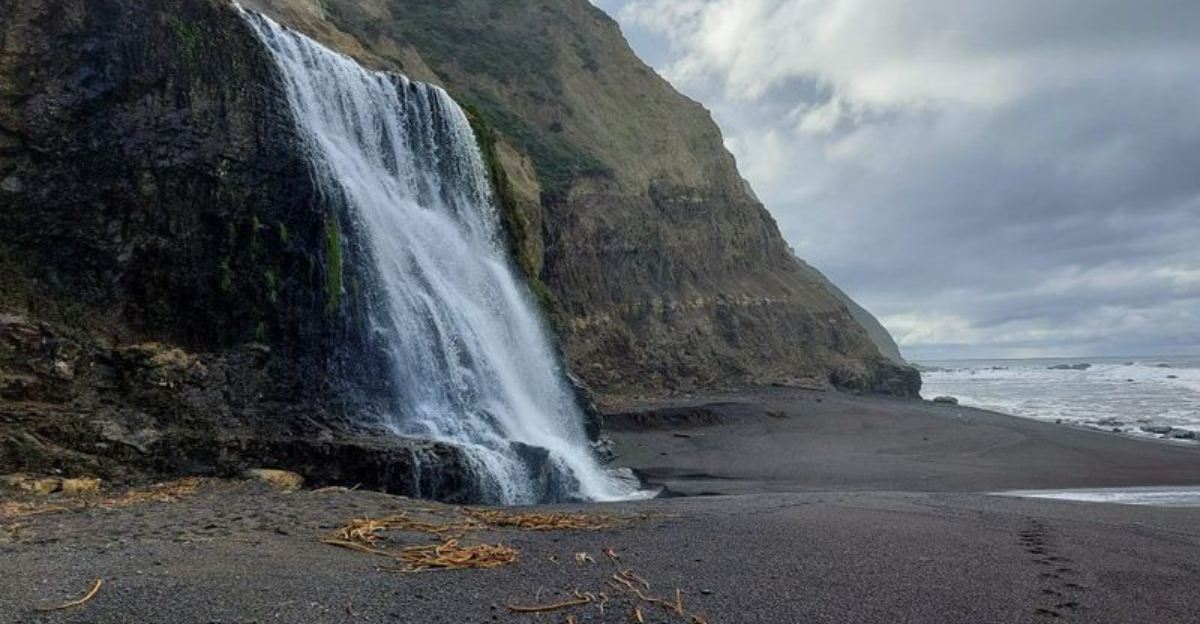This 40-Foot California Waterfall Is So Beautiful, It’s Worth The Long Drive

Hidden along the rugged coastline of Point Reyes National Seashore lies one of California’s most spectacular natural wonders – Alamere Falls.
This rare tidefall plunges 40 feet directly onto the beach and into the Pacific Ocean, creating a scene straight out of a fantasy novel.
I discovered this gem during a weekend hiking trip last spring, and despite the challenging journey to reach it, the breathtaking view made every step worthwhile.
1. A Rare California Tidefall Worth The Effort
Alamere Falls stands as one of only two tidewaters in California where freshwater cascades directly into the ocean. My jaw literally dropped when I first glimpsed this natural marvel after emerging from the coastal trail. The water tumbles dramatically over a 40-foot cliff, creating misty rainbows when sunlight hits just right.
Unlike typical waterfalls tucked away in mountain valleys, Alamere’s oceanside location creates a magical contrast between freshwater and saltwater worlds. The surrounding cliffs frame the falls perfectly, with wildflowers dotting the landscape in spring.
Fun fact: geologists estimate these falls formed thousands of years ago when earthquake activity altered the natural drainage patterns of the coastal watershed. Now it stands as one of Point Reyes’ most photogenic and sought-after destinations.
2. The 8.4-Mile Journey From Palomarin Trailhead
Getting to Alamere Falls involves an 8.4-mile round-trip hike that begins at the Palomarin Trailhead near Bolinas. I remember lacing up my hiking boots that morning, blissfully unaware of the adventure ahead. The trail starts innocently enough, winding through fragrant eucalyptus groves before opening to spectacular coastal views.
About halfway through, you’ll encounter several small creek crossings that can become tricky after rainfall. Pack sturdy waterproof boots and trekking poles if you have them.
The path features moderate elevation changes rather than steep climbs, making it accessible for reasonably fit hikers. My GPS tracker showed we gained about 1,300 feet in elevation throughout the journey, with plenty of stunning ocean vistas providing perfect excuses to catch your breath.
3. Scenic Stops: Bass Lake And Pelican Lake
Halfway to Alamere Falls, two gorgeous lakes appear like mirages in the coastal landscape. Bass Lake greeted me first, its calm waters reflecting the sky so perfectly I nearly walked right past thinking it was just more horizon. Many hikers take a refreshing dip here during warmer months before continuing their journey.
Just beyond lies Pelican Lake, slightly smaller but equally charming with its lily pads and occasional waterfowl visitors. I spotted a great blue heron stalking the shallows, completely undisturbed by our presence.
Both lakes offer perfect picnic spots with fallen logs serving as natural benches. These tranquil waters create a striking contrast to the crashing ocean waves you’ll encounter later at the falls, making the journey feel like traversing multiple ecosystems in a single hike.
4. The Challenging Spur Trail To The Falls
Reaching the actual falls requires navigating an unmarked spur trail that branches off the main Coast Trail. I nearly missed it myself! Look for a small dirt path veering right about 4 miles in, just after passing the Alamere Falls Trail sign.
This final stretch descends steeply through dense brush and requires some scrambling down a cliff face. My heart raced as I carefully picked my way down, gripping exposed roots and rocks for support. The Park Service doesn’t maintain this section, and it can be treacherous after rainfall.
Despite the challenge, that final approach builds delicious anticipation. The roar of falling water grows louder with each step, until suddenly the brush clears and—boom!—the magnificent falls appear before you, tumbling from the bluff directly onto the beach below.
5. Seasonal Beauty And Best Times To Visit
Winter and early spring showcase Alamere Falls at its most dramatic, with recent rainfall amplifying the cascade to thunderous proportions. My March visit coincided perfectly with peak flow, and the falls roared with such intensity that conversation became impossible within twenty feet.
Summer brings more manageable water levels but compensates with wildflower displays along the trail. Yellow lupines and orange California poppies created a natural carpet during my return visit in June. The beach below the falls also becomes more accessible in drier months, allowing closer exploration.
Aim for weekday visits to avoid crowds, especially between April and October. I’d recommend starting early—around 8 AM—to secure parking at the limited Palomarin lot and enjoy some solitude at this increasingly popular natural wonder.
